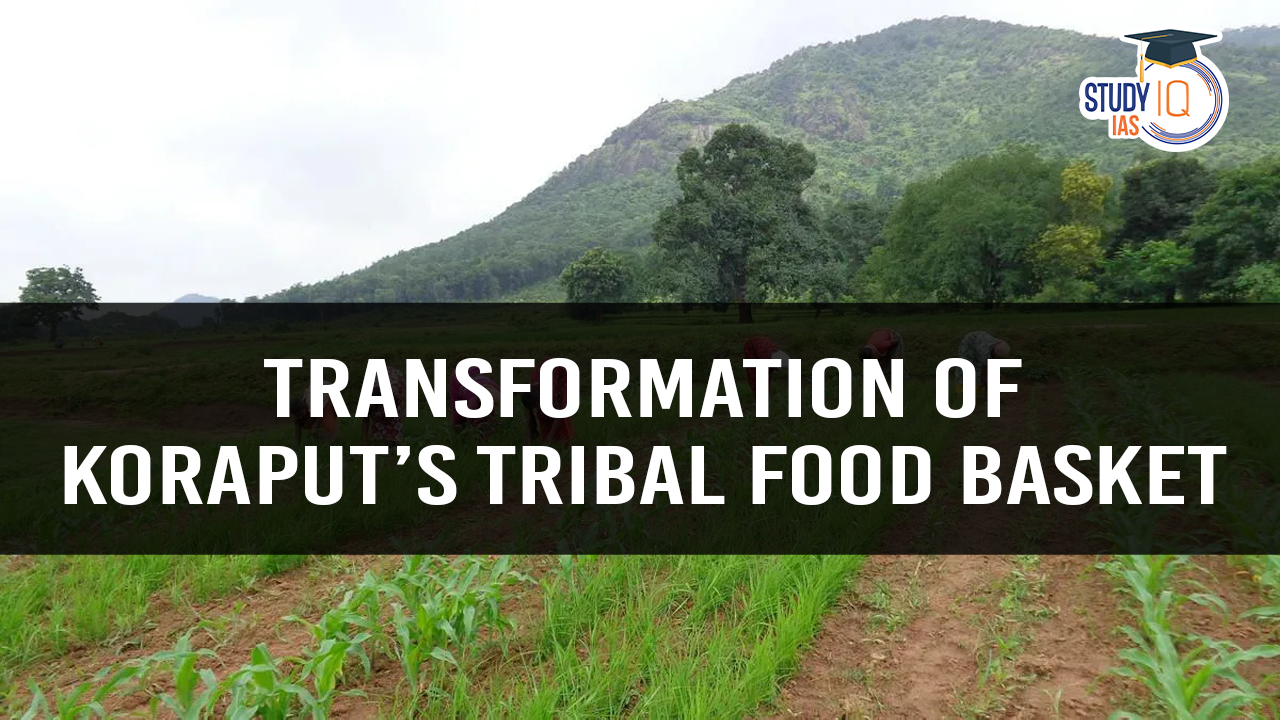Table of Contents
Introduction
Koraput, a district in Odisha, is a biodiversity-rich region with a predominantly tribal population. Despite several government schemes, the district suffered from high levels of undernutrition and poverty.
According to NFHS-5 (2019-21) data
- 43% of children under five years are stunted (low height-for-age).
- 33% of children are underweight.
- Only 17% of children receive an adequate diet.
- More than 50% of women suffer from anaemia.
Nutrition Security Transformation Model (2013-2022)
- To address this issue, the M.S. Swaminathan Research Foundation (MSSRF) initiated a community-based nutrition literacy program (2013-2022) to empower tribal communities toward nutrition security.
- Objectives:
- Diversify household food baskets with nutritious foods.
- Enable nutrition-sensitive farming (crop diversity, backyard poultry, pisciculture).
- Improve sanitation, hygiene, and Infant and Young Child Feeding (IYCF) practices.
- Facilitate community-driven transformation toward nutrition security.
Implementation Strategy
Step 1: Community Sensitization
- Assessing nutritional status of women, children, and adolescents.
- Consolidating secondary data and presenting findings to the community.
- Engaging in discussions to identify nutrition challenges and solutions.
Step 2: Selection of Community Champions
- Villagers nominated men and women from various caste groups.
- Selected individuals underwent a residential training program on nutrition and farming.
Step 3: Residential Training Program
- Conducted over six months with sessions lasting 2.5 days each.
- Topics covered:
- A balanced diet and dietary diversity.
- Sanitation, hygiene, and IYCF practices.
- Nutrition-sensitive agriculture (crop diversification, backyard poultry, pisciculture).
- Engagement Methods:
- Group discussions, role-playing, interactive learning.
- Real-life scenario analysis and problem-solving.
- Exploring caste, class, and gender-based nutrition disparities.
- Key Learnings from the Training:
- Participants realized the importance of eating both dal and vegetables daily.
- Awareness increased about traditional rice varieties as a nutritional asset.
- Participants shifted focus from “dish count” to “food group count” for dietary diversity.
Community Engagement and Capacity Building
Strengthening Social Cohesion
- Training programs broke hierarchical barriers, enabling men and women to interact across villages.
- Participants planned crop diversification strategies and home garden expansion.
- Recognized the power of collective decision-making to demand government entitlements.
- Created songs and messages on a balanced diet, hygiene, sanitation, and women’s support.
Empowering Community Champions
- Over 200 men and women from 70+ villages became “community champions”.
- Identified further training needs in: Seed treatment, Vermi-composting & organic fertilizers, Mushroom production etc.
- Over 1,000 villagers trained over 10 years, creating a sustainable resource base.
Impact and Outcomes – Agricultural Transformation
Crop diversity increased significantly
- Before: 71% of households cultivated only 2-3 crops.
- After: Over 60% of households cultivated 4-5 crops.
Home gardens became more productive
- Before: 90% had home gardens for only five months.
- After: 50% had home gardens operational for 7-9 months.
Dietary diversity improved
- Households began consuming 9-11 varieties of crops (up from 4 varieties).
- Increased intake of pulses, leafy vegetables, tubers, fruits, poultry, fish, and wild food.


 Utkal Divas 2025: Odisha Foundation Day ...
Utkal Divas 2025: Odisha Foundation Day ...
 List of Military Exercises of India 2024...
List of Military Exercises of India 2024...
 GPS Spoofing and Its Impact in India: A ...
GPS Spoofing and Its Impact in India: A ...





















